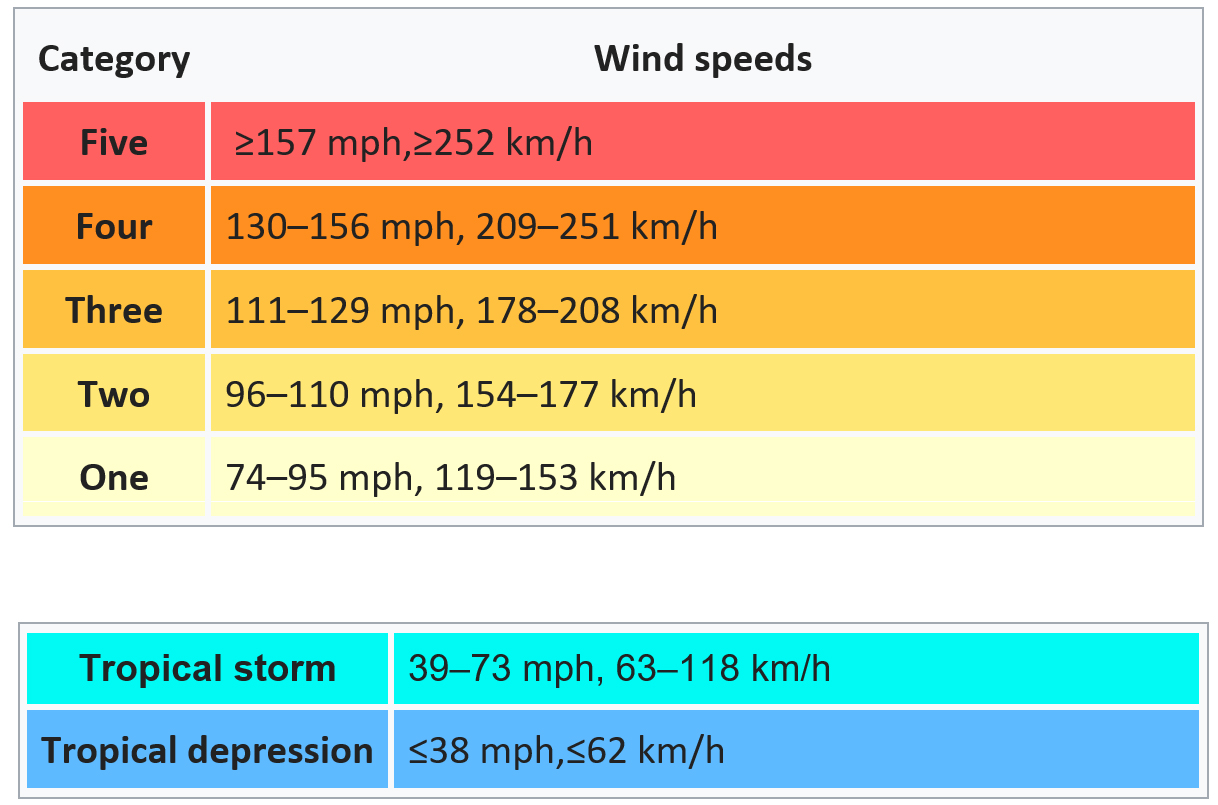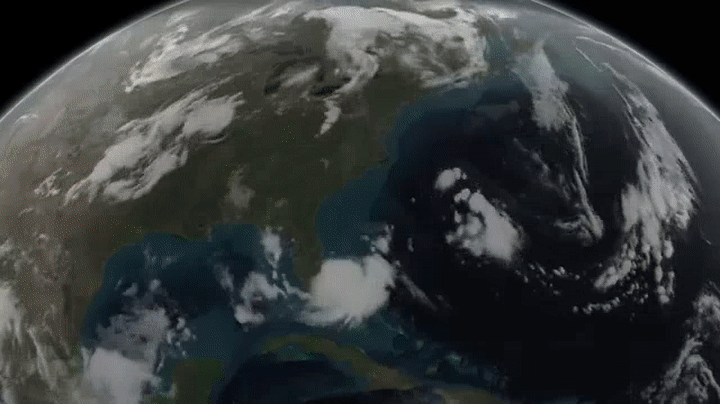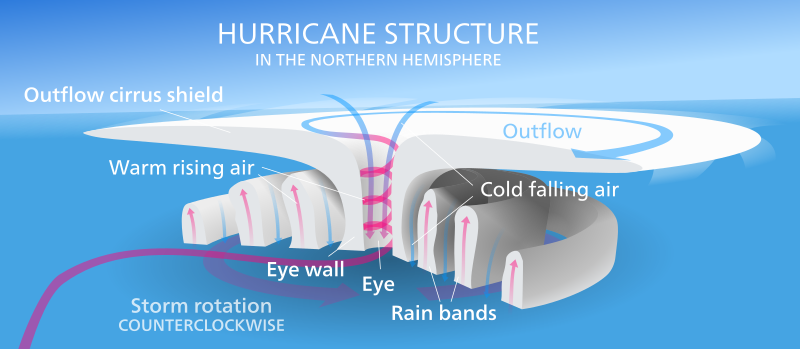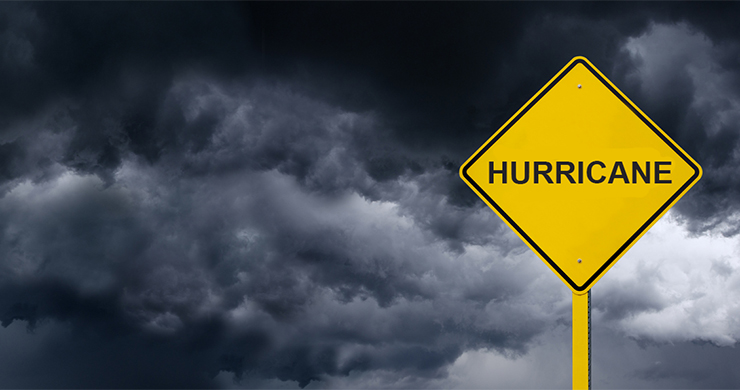Explaining Hurricanes
Hurricanes are tropical storms with wind speeds above 119 km/hr (74 mph).
Hurricanes are divided into 5 categories in the Saffir-Simpson scale.

Tropical storms form over warm ocean surfaces; normally the sea surface needs to be at least 27˚C for a tropical depression to develop into a hurricane strength storm.
Remember that the name hurricane is used mostly in the oceans and seas bordering the Americas. Elsewhere they are known as either typhoons or cyclones.
Warm ocean surfaces provide two things for the air above them:
- Heat
- Water Vapour
This is important as the heat warms the air and the air starts to rise.
However to really understand what goes on we need to know that there is two types of heat:
- Sensible Heat
- Latent Heat
Sensible heat is heat that increases the temperature – simple really.
Think of a science experiment where you use a Bunsen burner underneath a beaker of water; if you measure the temperature of the water it will increase until the temperature reaches 100˚C.
Latent heat is heat that is used to change the state of matter such as from a liquid to a gas.
If you think about your science experiment that if you keep on heating your water with a Bunsen burner after it has reached 100˚C the temperature will not increase.
So where does all of the heat energy go?
It goes into turning the liquid into a gas – a process called evaporation.
This is important in hurricanes because if the gas turns back into a liquid it will release the latent heat back into the air. This process happens along with condensation and it is very important.

Image: Global tropical cyclone tracks-edit2 © Wikimedia Commons
Tropical Storm Tracks 1985-2005
The map above shows the areas where tropical storms form and the areas that they migrate through.
There is a band with virtually no storm tracks over the Equator and up to 5˚ North and South of it.
This is because there is not enough Coriolis force (the spinning force of the Earth) to form a rotating core. Think about water spinning down the plug hole.
The main things needed for Tropical Storms/Hurricanes are:
- Warm ocean surface temperatures (higher than 26.5˚C)
- Provides Sensible Heat and
- Latent Heat in the form of water vapour.
- Sufficient Coriolis force
- Normally not found within 500km of the Equator
- Without enough Coriolis force water vapour (latent heat) will not become concentrated around a central region from a much wider area.
Formation
1. As the air above a sufficiently warm sea surface warms the molecules making up the air expand and as they are now lighter than the air above they rise.
2. Rising air forms lower air pressure – see linked article 2.
3. Air moves in from surrounding areas of higher air pressure.
4. The rising air and air moving in from areas of higher pressure rotates around the central area of low air pressure.
- This is caused by the Coriolis force

Image: Typhoon saomai 060807 © Wikimedia Commons
5. As this process starts the rotation starts to concentrate the denser air carrying water vapour increasingly in the centre.
6. The rising air at the centre cools and water vapour condenses; this releases latent heat.
7. The latent heat becomes sensible heat which warms the surrounding air causing it to rise again very rapidly creating very low air pressure.
8. Warm moist air from surrounding areas rushes in quickly to fill the area of very low air pressure.
a. More warm wet air to keep powering the ever deepening central low pressure area.
b. Air rushing in is wind.
c. The wind spirals in creating giant swirls of clouds several hundreds of km across.
9. As long as the hurricane stays over warm water it will continue to get stronger.
- Hurricanes lose strength if the move over land or cooler ocean areas.

Image: HurrArthur720p © Wikimedia Commons
10. Hurricanes form bands of clouds rotating around a central eye.
11. Inside the eye conditions are calm.
12. The strongest winds are found within the eye wall.

Image: Hurricane-en © Wikimedia Commons under the Creative Commons Attribution 3.0 Unported license
Hurricane Hazards
- Strong winds especially in the eye wall can damage buildings directly and can pick up debris to cause further damage or danger of injury and death.
- Rainfall the large amounts of water vapour condensed in a hurricane causes very intense and prolonged rainfall. This can cause flooding but may also trigger landslides.
- Storm surges:
Because of the low air pressure sea levels rise (less air pushing down on the sea surface)
Combined with very large waves caused by the strong winds.
Between these two flooding from the sea can be disastrous. The storm surge is often the most dangerous aspect of a hurricane.

Image: Hurricane Ike Gilchrist damage © Wikimedia Commons
Student Activity
- What things are necessary for a hurricane to form?
- Why does a hurricane lose strength:
a. If it passes over land?
b. If it passes over cooler seas?

